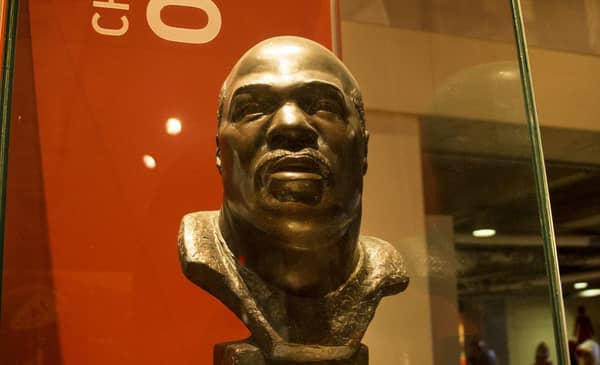
In The NFL, Monday Night Football is always full of unpredictable outcomes. When the 1990 NFL season was underway, two rival teams the Denver Broncos and the Kansas City Chiefs met on a Monday night. This Broncos home game lived up to every bit of the hype leading up to the game. No one would have ever imagined the game would produce the hit that stopped Christian Okoye in his tracks.
Whenever the Chiefs visited Mile High Stadium there always seemed to be a suspenseful ending. To add to that, there is no secret both teams battle yearly for home field advantage in the AFC Conference. The game was monumental and played on September 17, 1990. Both teams featured two all star players who sealed their fate in NFL lore.
During the 90s, professional football was still violent but organic enough to allow cartoonish tackles in the field of play. Over the past several decades, pro football has diminished into questionable rule changes with no flexibility to protect a brand.
Okoye’s Long Journey
The Kansas City Chiefs possessed a freakish in nature running back by the name of Christian Okoye. Okoye grew up in Enugu, Nigeria but did not learn to play football until he moved to The United States in the mid-80s. As a teenager, Okoye followed the path of a friend from Nigeria in track and field. His friend attended a small school, Azusa Pacific University, located East of Los Angeles, California.
At the urging of childhood friend Innocent Egbunike, the Azusa Pacific track and field coaches offered Okoye a scholarship. Although he lacked a basic understanding of contact football he eventually joined the team.
Okoye adjusted to the game quickly and took the sport by storm. He was drafted in the second round by The Chiefs in 1987. During his third season, Okoye gained the name the “Nigerian Nightmare“ due to his punishing tackle-breaking running style. He was 6’1″ 260 lbs. with pads and ran 4.45 in the forty-yard dash.
Imagine how terrified defenders would be when the ball was handed to Okoye and he gained full speed ahead. Essentially this was a specimen of a man in full gear. That being said, the foreshock was already in motion leading up to that Monday night game. The Denver Broncos was one of The Chiefs biggest divisional rivals in the AFC West. Over the past 20 years, both teams have played some close but hard-fought games between the two franchises. The Broncos defense was more finesse but formidable to compliment the high scoring offense led by star quarterback John Elway.
The Mile High Assassin
The Denver Broncos selected Arkansas safety Steve Atwater in the 1st round with the 20th pick in 1989. The Broncos wanted to improve their defense, after prior losses in Super Bowls XXI and XXII. Both losses were by 81 points combined to the New York Giants and Washington Redskins. Broncos head coach Dan Reeves expressed his desire to build a more physical and aggressive defense after the two disappointments.
By choosing Atwater, the team was focused on adding the missing defensive pieces of the puzzle. Atwater stood at 6’3″ and 220 lbs. at free safety playing alongside veteran strong safety Dennis Smith. His mental and physical prowess made him a standout free safety in the NFL. Atwater was a fearless hitter and defensive enforcer policing the Broncos secondary.
The Play
A big collision was always in the making with any team because of Okoye’s invincible running style. He displayed a physical superiority to bull over, drag and emasculate defenders. His power running style even included running over defensive linemen.
The battle started slow and transgressed into a small lead for the Broncos then the Chiefs blocked a punt late in the game and recovered on their 22-yard line.
After several run plays, the Broncos defense anticipated another handoff to Okoye. Atwater was mic’d up for the game and having fun flying around. He waited patiently for an opportunity to lower the boom on Okoye.
The Chiefs quarterback handed off the ball to Okoye on a dive play. There was a gaping hole Okoye cut back into and Atwater had already made a break in Okoye’s direction, he closed in at a blazing speed. He collided and delivered a blow that stopped Okoye in his tracks.
The television replay played multiple times, showing Atwater standing over Okoye at the point of contact. Okoye picked himself up after the play, and he was never the same symbolic runner thereafter. A few years later Okoye retired from football ending an impressive storybook career.
As for Atwater, he became an instant symbol of a big hitter, which signified the Broncos defensive personality. Atwater moved on winning several Super Bowls to solidify his legacy of a Mile High assassin. That play connected both men forever that night in Denver.
